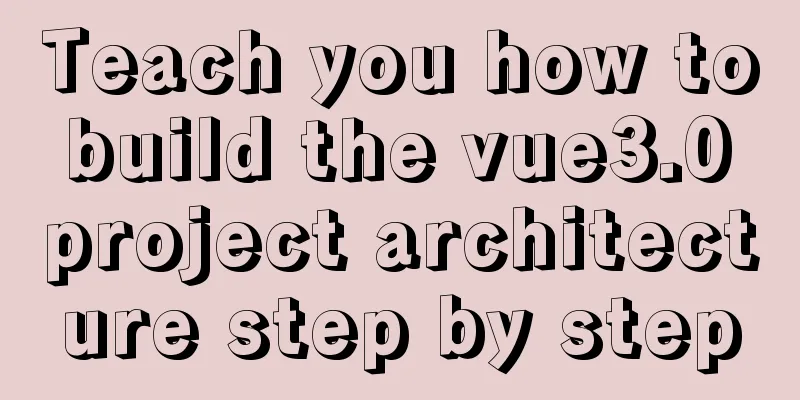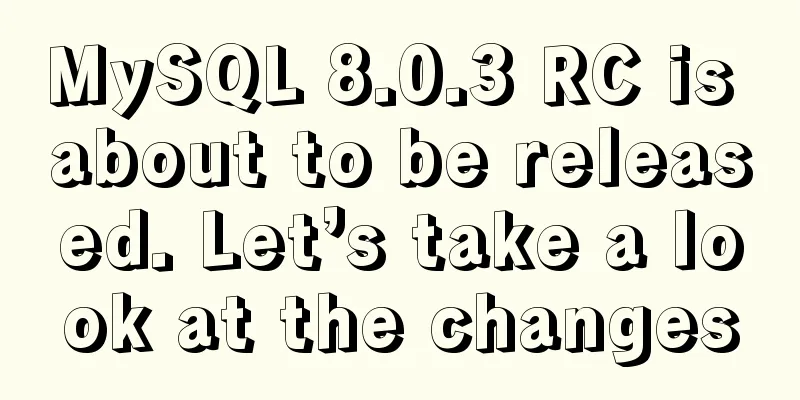Teach you how to build the vue3.0 project architecture step by step

Preface:I have open-sourced the vue-cli and vue-cli3 libraries on GitHub. The GitHub repository address will be attached at the end of the article. This time I rewrote 2.0 and optimized it. Then, according to the functions and codes of 2.0 and the syntax of vue3.0, it was completely rewritten. Although the name is cli, both libraries are actually created based on vue-cli. The purpose of doing this is to quickly start the project at work. After all, slicing and packaging, less, axios, vuex, router, UI framework, basic file directory, permissions, these are all basic operations. Of course, different projects still require some adjustments. The master branches of these two projects are the most basic ones, and also contain several custom components. vue-cli3 has cut out a separate app branch, this branch will add some features from time to time, such as hightCharts' Gantt chart, three.js, user-customizable large-screen display and other features. There is nothing now, it depends on the time, it will be updated when there is time. Vue3.0 will be written first, and 2.0 will be discussed later. I also hope that everyone can help me improve this library. After all, it is built to quickly start the project, so the better the better. The app branch also hopes to have some good functional module cases to expand everyone's thinking. 1. Create a project with vue-clinpm uninstall vue-cli -g Uninstall the old version of cli npm i @vue/cli -g install the new version of cli npm install -g @vue/cli-init Install cli vue -V Check the version number of cli, pay attention to uppercase and lowercase vue create vue-cli create vue3.0 project, remember to select vue3 Just follow the above steps. My vue-cli version number is 4.5.11. Please note that when creating a project, you need to manually choose whether to create a 2.0 or 3.0 project. The default is 2.0, and the scaffolding is backward compatible.
2. Install Routernpm install vue-router@4 Install routing, version 4.0 My router version is 4.0.12 3. Improve the directory structure and create the configuration file vue.config.jsThe directory and vue.config.js are posted here. For details, please go to GitHub to view the source code directly. I will not take up much space here. Here, app.less sets the color variables to unify the colors of the entire system, which will facilitate maintenance if you create a theme later. Among them, antd, vuex, etc. will be discussed later.
4. Install ant-design-vue, install less, and install dayjsnpm i --save ant-design-vue@next Install antd3.x version 3.0 is still in the stage of continuous update npm install babel-plugin-import --save-dev Import babel, configure babel.config file, and load antd components on demand npm install --save @ant-design/icons-vue If necessary, import antd's icon npm install less --save Import less npm i [email protected] Note the version number npm i style-resources-loader vue-cli-plugin-style-resources-loader -D Install the plugin, vue.config.js file, add less file global configuration, mainly configure global variables npm install dayjs --save and configure dayjs globally. If an error occurs, reinstall ant-design-vue. dayjs is lighter than moment. I used ant-design-vue as the UI framework, and you can choose it according to your needs and preferences. However, I would like to remind you that the current version 2.0 of antd supports vue3 and is stable. We are currently upgrading to version 3.0. The project uses the 3.0 writing method, and its stability remains to be verified. Also, because antd needs dayjs, dayjs is also used here. The usage is similar, but it is very small. The project uses antd's on-demand loading. It is better not to introduce unused components. If necessary, just introduce them in the antdUse.js file. The on-demand loading method is described in detail in the official documentation, and requires modifying babel.config.js. The icon of antd3 is introduced in the form of components, which is a bit cumbersome to use and requires attention. When installing babel of less, pay attention to the version number. A higher version will result in an error. I have defined a global less variable here to unify the font size, colors, etc. at all levels of the project 5. Install vuex and axiosnpm install vuex@next --save Install vuex and configure npm install axios Install axios and make unified configuration There is no change in axios. Vuex recommends taking a closer look at the official 3.0 to 4.0 migration documentation. Here I will briefly list a few important ones. In the new version, use createStore to create an instance; get the current vuex instance through useStore. See the code for specific writing methods. 6. Some new syntax of vue3Vue3 refers to the implementation method of react hooks, so the writing style and programming ideas are very similar. It is highly recommended to read this article by Mr. You Yuxi. Click here to jump. He explained the causes and consequences of his upgrade in detail. After reading it, you will have a clearer understanding of this upgrade. This update mainly makes major changes to the extraction and reuse of common component logic and the logical organization of a single component. Of course, the fundamental driving force is still the support for TypeScript. ts is the general trend. From my personal point of view, this change is very big, making Vue3 very difficult for novices to get started. The requirements for programmers have also increased a lot. It is easy to have a mess of code and confusing logic. Uh... Also, the writing of .value and props. is too wordy. Am I being too demanding? I’m so annoyed, haha. However, after using it more often, you will find it very useful and convenient. The data flow of vue3.0 is very clear and it also retains the old advantage of data responsiveness. It's very comfortable. The blogger used react at first, and was not used to vue at the beginning. There were reasons for the writing style, but the biggest problem was that the data was not clear. All the data was bound to this, which made the readability much lower. . . . Let's get back to the point and talk about what changes Vue3 has made and how to use it according to my understanding. First of all, vue3 supports typescript, applause and flowers. . . It is recommended to learn it, but of course it doesn’t matter whether you use it or not. It can only be said that ts, as a superset of js, has completely cut off the unruly and freedom-loving nature of js and made it more conventional. It also makes the code more standardized and more controllable. But what's interesting is that vue3 completely cuts off the rules and regulations of vue2 and completely releases freedom. Variables and methods are directly defined in the setup, and the logic is also written in it. There is no need to declare monitoring properties and declaration methods in the prescribed place as before. This project is written in js, and my ts level is average. I am also afraid that everyone will not be used to it. After all, the popularity of ts is still a bit low at this stage. Some changes are listed below, with source code and comments. It is better to just pull the project and run it. Here I will just briefly mention some key changes. main.js file. Create a vue instance through the createApp method and add global properties to the instance prototype through app.config.globalProperties. Multiple instances can be created without fear of pollution. report.js file. Declare components through defineComponent and use the setup function to develop component logic. For details, see the report.js source file. The combination function setup(props, context) directly replaces the entire set of writing methods such as vue2.0 computed watch lifecycle methods. All logic is implemented in this function. Therefore, it is recommended to unify the writing style. Although the previous writing style is also supported, my personal suggestion is to either use the previous style or not use it at all. Do not allow setup and methods to appear at the same time.
VII. ConclusionThere are many new properties in Vue3, so please study and read the documentation. However, the community is not yet very complete. I personally feel that by the end of 2022, it should be improved a lot and most dependencies will be supported. Finally, if you think this project is well written, please give it a star. If there are any problems with the code, I hope you can correct them. If you have any good components or effects, please share them. Just in case the project needs it, I will use it, haha. vue-cli address vue-cli3 address This concludes this article on how to build a Vue 3.0 project architecture. I hope it will be helpful for everyone’s study, and I also hope that everyone will support 123WORDPRESS.COM. You may also be interested in:
|
<<: Compatibility issues when inserting audio files in HTML and playing them in browsers
>>: Detailed explanation of setting Context Path in Web application
Recommend
Four practical tips for JavaScript string operations
Table of contents Preface 1. Split a string 2. JS...
Introduction to MyCat, the database middleware
1. Mycat application scenarios Mycat has been dev...
MySQL 8.0.16 installation and configuration method graphic tutorial under Windows
This article records the installation graphic tut...
How to change the dot in the WeChat applet swiper-dot into a slider
Table of contents background Target Effect Ideas ...
In-depth explanation of SQL statement execution (MySQL architecture overview -> query execution process -> SQL parsing order)
Preface: I have always wanted to know how a SQL s...
Use Xshell to connect to the Linux virtual machine on VMware (graphic steps)
Preface: I recently started to study the construc...
Summary of principles for writing HTML pages for emails
Since HTML email is not an independent HOST page o...
The meaning of the 5 types of spaces in HTML
HTML provides five space entities with different ...
About the bug of better-scroll plug-in that cannot slide (solved by plug-in in 2021)
Better-scroll scrolling principle As a parent con...
Steps to repair grub.cfg file corruption in Linux system
Table of contents 1. Introduction to grub.cfg fil...
How to set remote access permissions in MySQL 8.0
The previous article explained how to reset the M...
Summary of 3 ways to lazy load vue-router
Not using lazy loading import Vue from 'vue&#...
Example of how to quickly build a Redis cluster with Docker
What is Redis Cluster Redis cluster is a distribu...
Detailed explanation of Axios asynchronous communication in Vue
1. First, we create a .json file for interactive ...
Solution to nginx-ingress-controller log persistence solution
Recently I saw an article on a public account tha...













